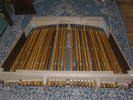 |
While the pedal board is out is a good time to clean it and to
check
for loose pedal caps. The cross-braces can temporarily be removed as
shown at left
for better access during cleaning and checking. I didn't find any
trouble with the black plastic caps for the flats and sharps, but some
of the maple caps for naturals had come loose. This can be
detected by pressing the pedal partway down, then releasing it quickly;
if you hear a rattle or buzz, then it's probably loose. Gently
tighten the three screws on the back of any loose cap. If any of
them can't be made "finger tight" or still rattle, you may have to
remove the key cap and rotate it 180 degrees, then re-install the
screws. Do this carefully to ensure that the key cap lines up
with the others. I found it helpful to stand the pedalboard on
its toe end and insert some pieces of
cardboard at the toe end of the key cap as a spacer to keep the cap
lined up while
putting in the first screw. If you have pets or small children,
never leave the pedalboard unattended while it is standing on its toe
end!
|